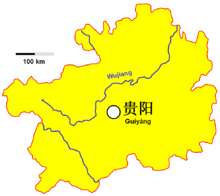Guiyang
| Guiyang | |
| — Prefecture-level city — | |
| Chinese transcription(s) | |
| - Simplified | 贵阳 |
|---|---|
| - Traditional | 貴陽 |
| - Pinyin | Guìyáng |
 |
|
 |
|
 |
|
 Guiyang
|
|
| Coordinates: | |
| Country | China |
| Province | Guizhou |
| Area | |
| - Total | 8,034 km² (3,101.9 sq mi) |
| Population (2003) | |
| - Total | 3,450,000 |
| - Density | 429.4/km² (1,112.2/sq mi) |
| Time zone | China Standard (UTC+8) |
| Postal code | 550000 |
| Website: http://www.guiyang.gov.cn/ | |
Guiyang (simplified Chinese: 贵阳; traditional Chinese: 貴陽; pinyin: Guìyáng) is the capital of Guizhou Province, the People's Republic of China.
Guiyang is located in central Guizhou province, situated on the east of the Yungui Plateau, and on the north bank of the Nanming River, a branch of the Wujiang River. The city has an elevation of about 1,100 meters. It has an area of 8,034 square kilometers.[1]
Contents |
History
The city was first constructed as early as 1283 AD during the Yuan Dynasty. It was originally called Shunyuan (順元), meaning obeying the Yuan (the Mongol rulers).
Originally the area was populated by non-Chinese. The Sui dynasty (AD 581–618) had a commandery there, and the Tang dynasty (618–907) a prefecture. They were, however, no more than military outposts, and it was not until the Yuan (Mongol) invasion of southwest China in 1279 that the area was made the seat of an army and a "pacification office." Chinese settlement in the area also began at that time, and, under the Ming (1368–1644) and Qing (1644–1911) dynasties, the town became the seat of a superior prefecture named Guiyang.
Locally Guiyang was an important administrative and commercial center with two distinct merchant communities, consisting of the Sichuanese, who lived in the "new" northern part of the city, and those from Hunan, Guangdong, and Guangxi province, who lived in the "old" southern part. Nevertheless, until the Sino-Japanese War (1937–45), Guiyang was no more than the capital of one of China's least-developed provinces. As elsewhere in the southwest, considerable economic progress was made under the special circumstances of wartime. Road transport infrastructure with Kunming in Yunnan province and with Chongqing in Sichuan (China's wartime provisional capital) and into Hunan were established. Work was begun on a railway from Liuzhou in Guangxi, and after 1949 this development was accelerated. Guiyang has subsequently become a major provincial city and industrial base. In 1959 the rail network in Guangxi was completed, allowing seemless connection from Guizhou to Chongqing to the north, to Kunming to the west, and Changsha to the east.
Administrative divisions
- Wudang District (乌当区)
- Nanming District (南明区)
- Yunyan District (云岩区)
- Huaxi District (花溪区)
- Baiyun District (白云区)
- Xiaohe District (小河区)
- Qingzhen City (清镇市)
- Kaiyang County (开阳县)
- Xiuwen County (修文县)
- Xifeng County (息烽县)
Geography
Guiyang has grown almost exponentially since the 1990s. The city's heart is around the 大十字 (literally "Big Ten") which is a cross, resembling the Chinese character for ten, and 喷水池 (literally "Fountain Pool") which is a fountain in the center of a rondpoint.
The city is situated on the Nanming River, a headstream of the Wu River, which eventually joins the Yangtze River at Fuling in Sichuan province. Guiyang is a natural route center, with comparatively easy access northward to Sichuan and northeast to Hunan province.
Climate

Guiyang is temperate and humid, and has a subtropical monsoon climate, with fairly mild winters and warm summers. The seasons are not particularly distinct. Unseasonably warm or cold spells are common although temperatures rarely reach extremes. Average highs are 49F (10C) in January and 83F (28C) in July.
Rain falls throughout the year, with occasional flurries in winter. It is also one of China's least sunny cities.
Economy
Guiyang is the economic and commercial hub of Guizhou Province. The GDP per capita was ¥11728 (ca. US$1420) in 2003, ranked no. 206 among 659 Chinese cities.
Coal is mined in the locality of Guiyang and Anshun, and there are large thermal generating plants at Guiyang and Duyun, supplying electricity for the city's industry. A large iron and steel plant came into production in Guiyang in 1960, supplying the local machinery-manufacturing industry.
Large deposits of bauxite have been discovered to the north, and by the 1970s Guiyang had become a major producer of aluminum. Guiyang also manufactures industrial and mining equipment, as well as railway vehicles and equipment. It has a large chemical industry, producing fertilizers, and a rubber industry, manufacturing automobile tires. Guiyang also has textile plants and makes glass, paper, and other consumer goods.
Demographics
Guiyang is populated by 23 different minorities (the most populous of which is the Miao people), in addition to the ethnic Han.
As of 2003 , the total population of Guiyang municipality was 3.45 million, among which 1.65 million were urban residents.
Transport
Transportation in Guiyang consists of an extensive bus system and many taxis. The relatively recently constructed Longdongbao international airport conducts air traffic. The main southern railway station is being rebuilt in 2008.
There is a high-speed rail line to and from Chengdu, Sichuan.
Education
The city is the cultural and educational center of Guizhou province and has a university, a teacher-training college, and a medical school.
- Guizhou University
Religion
On October 15, 1696, the city was made the seat of the Roman Catholic Apostolic Vicariate of Kweichow. This was suppressed in 1715 and restored in 1846. In 1924 it was renamed as the Apostolic Vicariate of Guiyang, and in 1946 it was promated to its current status as the Roman Catholic Archdiocese of Guiyang.
Sister cities
References
- ↑ "Profile of Guiyang" (in Chinese). Retrieved on 2008-06-11.
External links
|
|||||||||||||||||||||
|
||||||||||||||||||||||||
